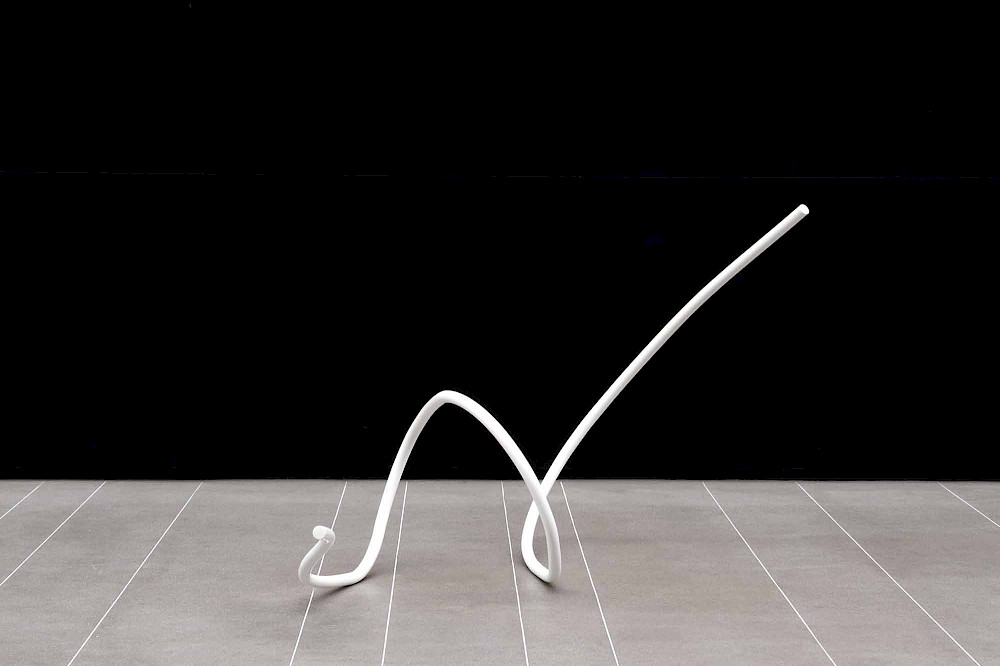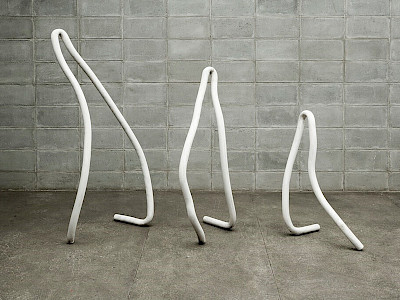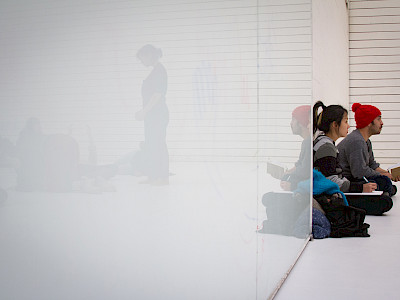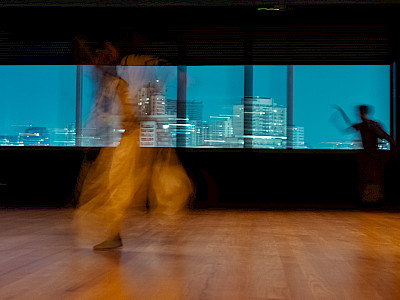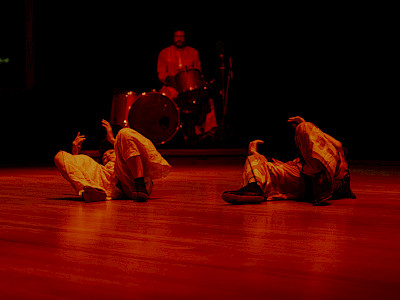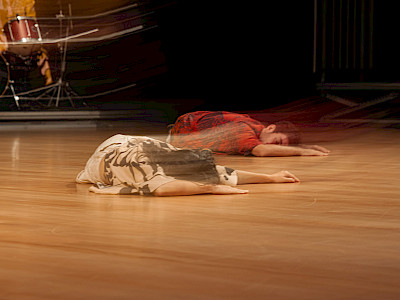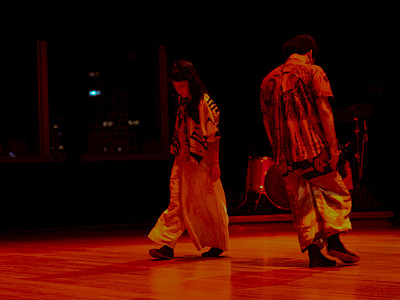12 — 16.05
Eduardo Fukushima, Beatriz Sano, Tomie Ohtake São Paulo
horizon
dance / visual arts
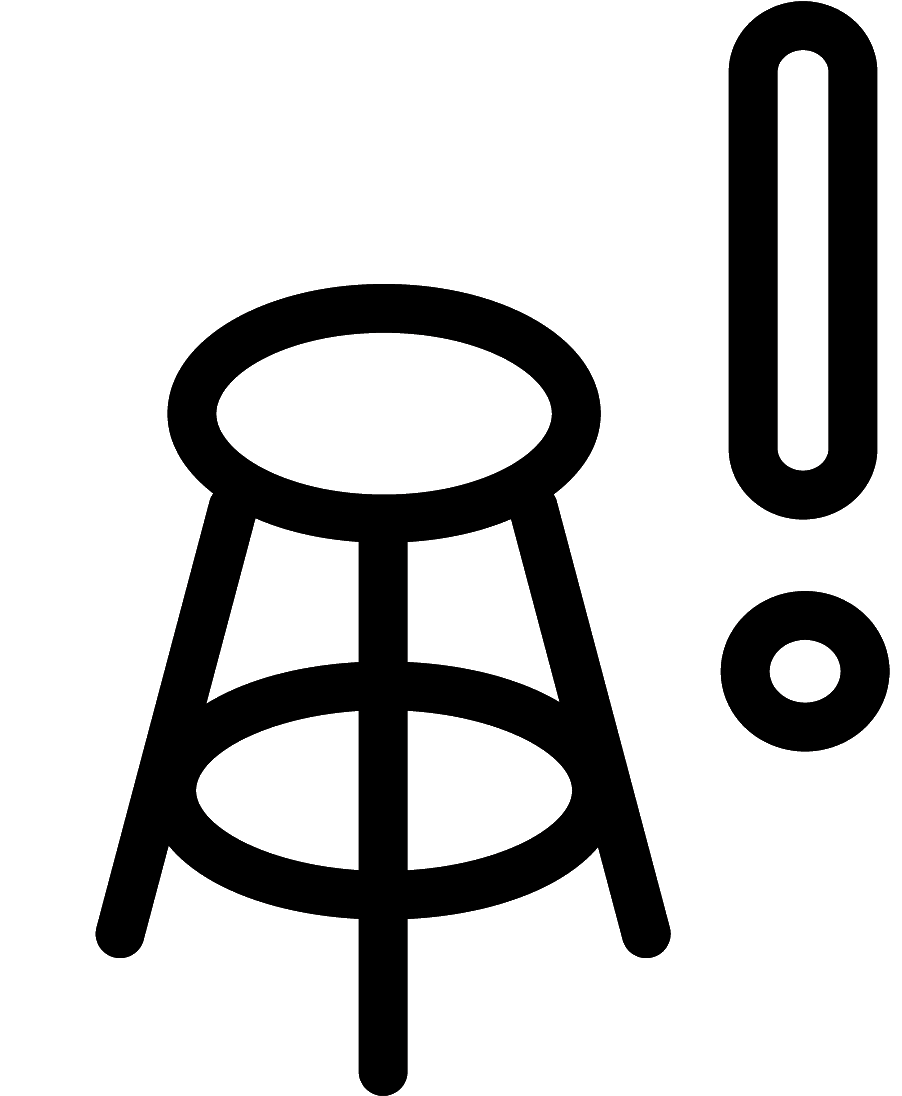 | ⧖ ±40min | €20 / €16 | re-creation
| ⧖ ±40min | €20 / €16 | re-creation
A line crosses the air; it is an immobile form, yet it seems to dance. The sculptures of Tomie Ohtake strike a balance between abstraction and the ability to awaken our imagination, between form and sensuality. Born in Kyoto in 1913, a young Ohtake moved to São Paulo, the largest Japanese community outside Japan, where she lived until her death in 2015. Her feeling of not belonging to just one place seems tangible in her work: every line is a movement against stability and fixed shape. For years, Eduardo Fukushima – a Brazilian choreographer of Japanese heritage – has been working on the loss of balance. For him, Ohtake and the link between instability and complex identity in her work serve as a great inspiration. Now, together with Beatriz Sano, he has conceived a choreography with the works of Ohtake. The space of WIELS is punctuated by her sculptures and the rhythms of a live drummer. As the breathtaking steps of Fukushima and Sano hypnotically transport us, like a gentle sea wave, making the space move, the sculptures almost appear to dance. While Ohtake’s pieces reside in major museums worldwide, horizon is the first chance to see them in Brussels, through a dizzying choreography of bodies and sculptures that presents a fascinating, unstable encounter with her work.
HORIZON
“At first, I thought: tension. [...] The problem of my sculpture is tension.”
Tomie Ohtake
Born in Kyoto in 1913, visual artist Tomie Ohtake moved at a young age to the city of São Paulo, Brazil, which has the largest Japanese community outside of Japan, where she lived until her death in 2015.
Encouraged by the Japanese artist Keiya Sugano, Ohtake began painting at the age of 40. Over the years, she developed a vast corpus of works characterised by a constant and assiduous search for synthesis, whether it be conquered by the economy of simple shapes broken in refined and concise compositions or by the balance between the free use of abstract forms, gestural impulse and meticulous care in the disposal of these elements. Ohtake’s work develops the threshold between intention and action, rationality and sensuousness in an impregnated matrix of aspects of Western painting that refer to the Japanese tradition.
Ohtake started out painting the landscapes she saw through her window and objects in her home, before breaking away from explicit figuration. Alongside her graphic works and paintings, she also created sculptures. Her threedimensional works materialise the free, gestural lines used in the lyrical abstraction of her paintings. With simplicity and lightness, her sculpture suggests flexibility and freedom, and invites viewers to perceive the surrounding void.
*
Choreographers Beatriz Sano and Eduardo Fukushima are also Brazilian citizens with Japanese ancestry. Throughout their professional careers they have studied Japanese and Chinese body practices alongside working with dance in different contexts for over fifteen years. Ohtake, Sano and Fukushima may be artists from different generations, but they are also contemporaries in their own time, sharing a sense of not belonging to just one place. Every stroke of Ohtake’s brush and every gesture of Sano and Fukushi- ma’s movement goes in the opposite direction to stability or fixed forms. Ohtake’s artistic work and the ambience of her home studio both provided the creative field for the construction of horizon.
The challenge of conceiving a work based on Ohtake’s oeuvre demanded a change in the choreographers’ methodology as they generally use improvisation to drive their creative processes. The duo’s immersion in Ohtake’s home studio, in her works and in the wealth of relevant critical texts led them to approach shapes like musical scores: non-figurative arrangements free of any a priori emotional charge and markings of rhythm with the singularity of the imperfect lines that configure circles and curves.
Specifically in Ohtake’s sculptures, they were interested in the deconstruction of balance that comes from the precise gesture of shaping imperfect forms still capable of rocking or remaining upright. Instability is achieved through the twists made by Ohtake in rigid materials such as steel, where the deformation and twisting of the line also destabilise the sculptures’ surroundings.
After exploring the forms, drawings and materiality of Ohtake’s paintings and sculptures, Sano and Fukushima developed a choreographic score that pays sophisticated attention to the cyclical and involuntary movements that inhabit the body after repetition. “Two that are one at the same time, opposing forces in the same form, like a magnet,” as the choreographers put it.
The choreography was composed simultaneously with the music, a drum piece created and performed live by Chico Leibholz. The three artists have developed the topographies between sound and dance, with the percussion sounds reverberating and emphasising the movement vibrations in time and also on the skin of the walls. The costumes designed by Rita Comparato (for the IRRITA brand) bring together her earlier research on prints, colours, modelling and cuts that enhance the body’s movements while proposing other possibilities of contour as the clothes blur the air, space and floor surfaces.
The dance is almost always performed horizontally on the floor, based on breathing and on the intensification of the body’s elementary movement of balancing and its spatial repercussions. The formation and deformation of lines and spaces punctuate a continuous, constant and uninterrupted pulse. The undulating quality of the movements is also reminiscent of Ohtake’s tubular sculptures, twisted forms of malleable geometry. Some respond to touch, oscillating between the force of gravity and the instability of form.
Playing with the perception of materials, what seems light is in fact very heavy, and what seems soft is actually made of iron – these are some of the sculptural characteristics that have influenced the movements in this dance duet. While some of Ohtake’s artworks can be found in major museums around the world, this is the first opportunity to see them together with horizon in Brussels at WIELS in a dynamic relationship with the choreographic piece. Both sound and movement create intimate contact between the curved and inert lines of the sculptures with the fascination of living and moving bodies.
Beatriz Sano, Júlia Rocha, Eduardo Fukushima, Isabel Ramos Monteiro
São Paulo, April 2024
12.05
- 19:00
13.05
- 19:00
14.05
- 19:30
- + aftertalk
15.05
- 19:30
- 21:00
16.05
- 19:00
Presentation: Kunstenfestivaldesarts, WIELS
Creation and performance: Beatriz Sano & Eduardo Fukushima | Sculptures and paintings: Tomie Ohtake | Music composer and performer: Chico Leibholz | Dramaturgy: Júlia Rocha | Stage director and expographic project: Hideki Matsuka | Costume design: Rita Comparato (Irrita) | Photos: Danielle Satiko, Vitor Barão, Ricardo Miyada | Video: Ricardo Miyada
Production: Corpo Rastreado
Commissioned and produced by Kunstenfestivaldesarts, in collaboration with WIELS
With the support of Instituto Tomie Ohtake
horizon is the project supported by the Friends of Kunstenfestivaldesarts in 2024
